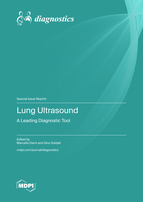Lung Ultrasound: A Leading Diagnostic Tool
A special issue of Diagnostics (ISSN 2075-4418). This special issue belongs to the section "Point-of-Care Diagnostics and Devices".
Deadline for manuscript submissions: closed (30 September 2022) | Viewed by 53567
Special Issue Editors
Interests: computer vision; medical image processing; ultrasound imaging; lung ultrasound
Interests: pulmonary medicine; intensive care; interventional ultrasound; thoracic ultrasound; non-invasive hemodynamics
Special Issues, Collections and Topics in MDPI journals
Special Issue Information
Dear Colleagues,
Today, the diagnostic value of the artefactual information provided by lung ultrasound (LUS) is widely recognized by physicians. By carefully observing LUS images, an expert physician can derive important information regarding the nature of a pulmonary disease. The mechanisms at the basis of the vertical artifacts have also been investigated, and similar events have been replicated on lung models in various research laboratories. As a result, plausible hypotheses on the genesis of artefactual information have been suggested, allowing the physician to link the observed artifacts to a pathological distribution of the alveoli.
Over the years, thoracic ultrasound has been extensively applied to assess numerous pleural and lung diseases (effusions, pneumothorax, consolidations, interstitial diseases involving the surface of the lung and, recently, COVID-19 pulmonary involvement). Sometimes, its diagnostic capability is reported as being better than that of traditional imaging techniques (chest radiography and CT). Even though the debate on the safety of ultrasound is still open, thoracic ultrasound is mostly accepted as an inexpensive and minimally invasive technique, and due to this additional aspect, LUS is becoming a leading diagnostic tool in the work-up of many cardiorespiratory diseases.
Given the success of this Special Issue and the current pandemic context that is highlighting the importance of lung ultrasound, the deadline for manuscript submissions has been extended to 30 September 2022.
We look forward to your contribution.
Dr. Marcello Demi
Dr. Gino Soldati
Guest Editors
Manuscript Submission Information
Manuscripts should be submitted online at www.mdpi.com by registering and logging in to this website. Once you are registered, click here to go to the submission form. Manuscripts can be submitted until the deadline. All submissions that pass pre-check are peer-reviewed. Accepted papers will be published continuously in the journal (as soon as accepted) and will be listed together on the special issue website. Research articles, review articles as well as short communications are invited. For planned papers, a title and short abstract (about 100 words) can be sent to the Editorial Office for announcement on this website.
Submitted manuscripts should not have been published previously, nor be under consideration for publication elsewhere (except conference proceedings papers). All manuscripts are thoroughly refereed through a single-blind peer-review process. A guide for authors and other relevant information for submission of manuscripts is available on the Instructions for Authors page. Diagnostics is an international peer-reviewed open access semimonthly journal published by MDPI.
Please visit the Instructions for Authors page before submitting a manuscript. The Article Processing Charge (APC) for publication in this open access journal is 2600 CHF (Swiss Francs). Submitted papers should be well formatted and use good English. Authors may use MDPI's English editing service prior to publication or during author revisions.
Keywords
- Essential physics of lung ultrasound imaging
- Diagnostic signs provided by lung ultrasound
- Guidelines in clinical care practice
- Biological effects of pulsed ultrasound
- Theoretical and physical lung modeling
- Visual and computer aided image analysis
- Spectral analysis of the radiofrequency (RF) signal
- Clinical and open ultrasound platforms.








